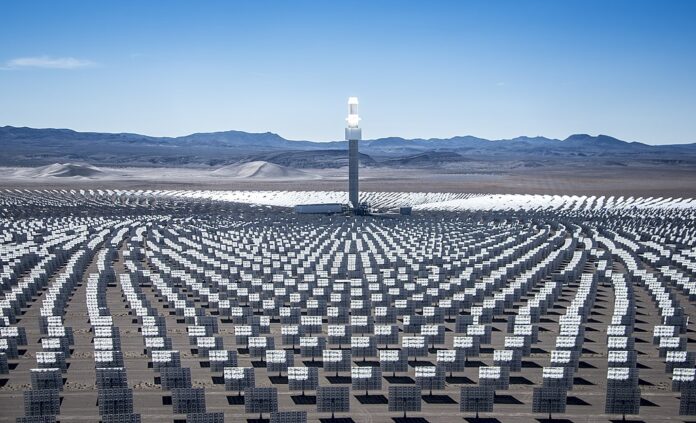The Kingdom’s Vision 2030 strategy is driving blue ammonia production, positioning Saudi Arabia as a leader in decarbonizing hard-to-abate industries
Saudi Arabia is at the forefront of the global transition to clean energy, with its significant investments in blue ammonia production emerging as a key factor in its energy transformation. As part of the ambitious Vision 2030 reform plan, the Kingdom aims to reduce its reliance on traditional fossil fuels by focusing on alternative energy sources, including blue ammonia and hydrogen.
This transformation is part of a broader strategy to decarbonize industries such as shipping, aviation, and heavy manufacturing, which are traditionally difficult to transition to cleaner energy due to their reliance on carbon-intensive processes. Blue ammonia, produced by capturing up to 90% of carbon emissions, offers a cleaner alternative that reduces environmental impact while supporting global efforts to combat climate change.
Saudi Arabia’s energy mix will consist of 50% natural gas and 50% renewables and alternative energy by 2030. In this context, blue ammonia has emerged as a central player, particularly due to its potential to fuel the growing hydrogen economy.
Embed from Getty ImagesOne of the Kingdom’s major breakthroughs in this arena came in 2020 when Saudi Aramco successfully shipped the world’s first carbon-neutral ammonia to Japan. More recently, Saudi Arabian Mining Co. (Ma’aden) exported 138,000 tons of blue ammonia to South Korea, one of the largest shipments of its kind globally. These milestones underscore Saudi Arabia’s leadership in this evolving energy landscape.
Meanwhile, the development of NEOM, a future smart city under Vision 2030, will feature the world’s largest green ammonia plant by 2025, further solidifying the Kingdom’s commitment to sustainable energy. Despite challenges such as the high costs of production and the need for technological adaptation, Saudi officials, including Abdulaziz Almizani, Chief Advisor of Energy and Sustainability, remain optimistic that costs will decrease as technology improves. Almizani highlighted that Saudi Arabia is implementing a circular carbon economy model, emphasizing the need to reduce, reuse, recycle, and remove carbon emissions. The Kingdom is also investing heavily in carbon capture, utilization, and storage (CCUS) technologies to convert CO2 into useful products, demonstrating its focus on sustainability.
Saudi Arabia’s regulatory framework has been designed to encourage private sector participation in this energy transition, further enhancing its role as a leader in the global clean energy movement. As blue ammonia production scales up and the Kingdom leverages technological advancements, it is well-positioned to offer a blueprint for other nations aiming to transition away from fossil fuels.
Analysis
Political: Saudi Arabia’s focus on blue ammonia has significant political implications, both domestically and globally. Domestically, it strengthens the Kingdom’s energy security by reducing its dependence on oil and gas. Politically, this transition supports the government’s long-term goals under Vision 2030, which aims to modernize the Saudi economy and reduce reliance on hydrocarbons. On the global stage, Saudi Arabia’s leadership in blue ammonia places it at the heart of international climate diplomacy. As nations around the world scramble to meet climate goals and reduce carbon emissions, the Kingdom’s advances in clean energy, particularly in sectors that are challenging to decarbonize, enhance its influence in global energy discussions and climate agreements.
Social: On a societal level, Saudi Arabia’s investment in clean energy has the potential to change the way the country approaches its economic and industrial future. The Vision 2030 agenda, which includes a focus on renewable energy and economic diversification, aims to reshape the social contract between the Saudi government and its people. By reducing dependence on fossil fuels, the Kingdom is paving the way for a more sustainable and diversified economy that can create new opportunities for employment and innovation. This transition also supports broader global societal goals of reducing carbon emissions and combating climate change, creating a more sustainable future for generations to come.
Racial: Although the racial dimensions of Saudi Arabia’s blue ammonia investments are not immediately apparent, the country’s leadership in clean energy could play a role in fostering global cooperation and collaboration across borders. As a key player in the global energy transition, Saudi Arabia’s innovations in blue ammonia could create new economic partnerships with countries in Africa, Asia, and beyond. These collaborations may involve knowledge sharing, technological advancements, and mutual investment, contributing to a more equitable global energy landscape that transcends racial and national divides.
Gender: The Saudi government has made strides in promoting gender equality, particularly through economic reforms aimed at increasing women’s participation in the workforce. The clean energy sector, particularly in blue ammonia production, offers new opportunities for Saudi women to contribute to the nation’s economic diversification. Through initiatives aimed at supporting female education and professional development in STEM fields, Vision 2030 is opening doors for women to take on roles in the energy sector, from research and development to leadership positions. This empowerment aligns with the Kingdom’s broader goals of fostering a more inclusive and equitable society.
Economic: Economically, Saudi Arabia’s investment in blue ammonia represents a critical step toward diversifying its economy beyond oil. The production and export of blue ammonia are already generating significant revenue streams, with major international deals such as the shipment of carbon-neutral ammonia to Japan and South Korea. These developments are positioning Saudi Arabia as a leader in the hydrogen economy, a sector that is expected to grow exponentially in the coming decades. Additionally, the investment in blue ammonia is helping to stabilize the Saudi economy by creating new industries and jobs, while also reducing its vulnerability to fluctuations in global oil prices.
As global demand for cleaner energy alternatives continues to rise, Saudi Arabia’s early leadership in blue ammonia production positions it as a key player in the future energy landscape. By embracing the circular carbon economy and investing in innovative technologies like CCUS, the Kingdom is demonstrating its commitment to achieving net-zero carbon emissions while maintaining its economic resilience.
